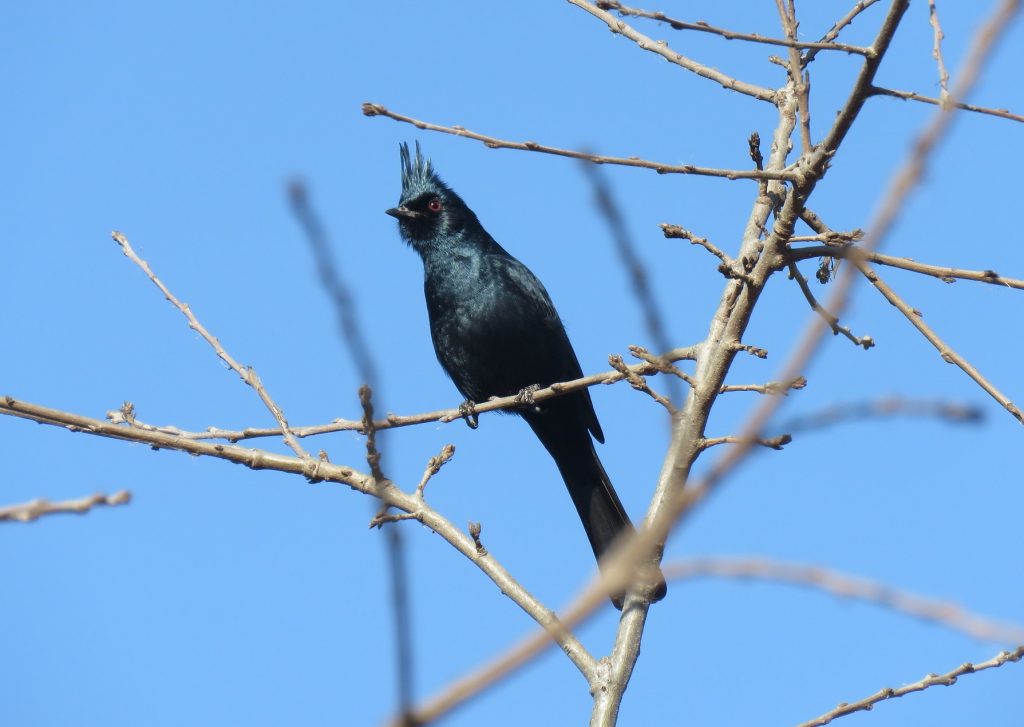Wednesday January 26, 2022

This handsome male Phainopepla (Phainopepla nitens) was captured by one of our fisheries technicians along the Stanislaus River. We commonly see this bird along riparian habitats gleaning mistletoe and other small berries from the nearby trees. Phainopeplas are relatively uncommon to see in California’s Central Valley, which is at the northernmost end of its range. That range extends from the various desert washes of Mexico and the southwestern United States, where they are more common, all the way up into California’s oak woodlands. Phainopeplas belong to the small family Ptiliogonatidae, also known as silky flycatchers, and are the only member that extends into the United States, as the majority of the species in the family are found in Central America and Mexico. The name “silky flycatcher” comes from the glossy plumage seen in males. The meaning of the name “Phainopepla” is also an homage to the beautiful males, as it means “shining robe” in the Greek language.
Despite their similar common names, Phainopeplas and other species of silky flycatchers are not closely related to our North American flycatchers (Tyrannidae). They are most closely related to cedar waxwings, which share a similar diet high in berries. Phainopeplas can be typically seen gorging themselves with berries from various treetops. They are best known for being amazing dispersers of different species of mistletoe, such as our local oak mistletoe (Phoradendron leucarpum) here in the Central Valley, or the desert mistletoe (Phoradendron californicum), in the southern desert region of their range. They even have a specialized digestive system to adequately process and spread the berries. Given that the berries are small and low in nutrients, the birds will consume more than 1,000 in a normal day. The pulp is digested, leaving only the seed to be excreted with other waste – which makes the perfect fertilizer for the developing seed. The berries move through Phainopeplas very fast, only spending about 12 minutes in the bird’s digestive system before being excreted.
Another interesting fact about Phainopeplas is their different nesting behaviors. In a desert habitat, a pair will build and defend a solitary nest near desert mistletoe. Resources are limited in the desert and sharing is not an option. The patch of mistletoe an adult pair feeds on must be guarded and protected for their growing fledglings. They will use the mistletoe to feed the brood until the desert becomes too hot and dry to find enough berries to sustain young. They then will have to move closer to rivers where a surplus of ripening berries allows Phainopeplas to nest colonially, and no longer be so aggressive. Besides mistletoe, these birds also enjoy berries of juniper, elderberry, grape, and even poison oak. Some Phainopeplas will reside year-round in riverside habitats where competition may be less intense.
At our river field sites we commonly hear the soft “hooet hooet’ calls of Phainopeplas as they communicate back and forth to each other. They stay in groups of four to six individuals that consist of mostly females along with one or two males. The males are often competing for the females’ attention by singing and dashing around the trees to show off their beautiful coloration. They provide some good entertainment and are a reminder to appreciate and enjoy the beautiful birds and their lovely songs that we encounter in the field.
